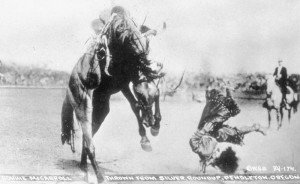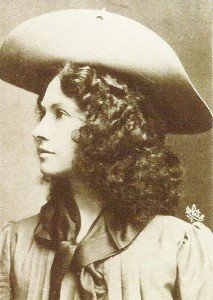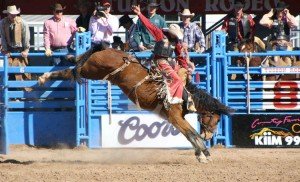There’s an old story that the name “cowgirl” was first uttered by none other than Theodore Roosevelt. As many people know, Teddy Roosevelt, was enamored by the American West and during this time in the 1880’s had traveled to the Badlands of Dakota Territory and bought himself a ranch. In fact, Roosevelt ultimately ended up with two ranches. The story goes that Teddy asked a young lady named Lucille Mulhall, fourteen years old, to rope a wolf on his ranch. Lucille did ride and rope the wolf and Roosevelt referred to her as a cowgirl. It’s been reported that from about that time on, the term cowgirl came into common usage. Lucille went on to be one of the first women to compete with men in roping and riding events. She was known as the “Rodeo Queen”, “Queen of the Western Prairie” and “Queen of the Saddle”. Many women during the early days of the professional rodeos were star attractions.
Thank you for reading this post, don't forget to subscribe!
Theodore Roosevelt, being from the east coast may not have known it, and probably didn’t, but women on horseback and performing ranch chores that are commonly attributed to cowboys was nothing new. The pioneers themselves traveling on the Oregon Trail often included women who did just about everything that a man did. It was a necessity more than a desire. Women rode horses, roped a steer, reined wagons and often times had to hunt for the family dinner. The difference is that these duties handled by women have not been publicized to the same extent as those of the cowboy or western pioneer male. Probably the best promoter of what a woman could do on horseback was Buffalo Bill Cody. Cody was at awe at the talent these female riders had. Buffalo Bill of course had his very successful Wild West on tour in the 1880’s and 1890’s and he was the man above all who could showcase the talent these early female riders possessed.
The Wild West’s biggest female star was Annie Oakley but Annie was a great sharpshooter. She wasn’t considered a star of horsemanship. Buffalo Bill did indeed employ women as riders and stunt riders. These included professional rodeo performers such as Georgia Duffy and Emma Lake Hickok. In fact, by the time Cody took his show to Europe he already had a list of trick riding cowgirls who could rope and race better than any man. This was in the 1880’s. It wain his show.s said that by 1887, Buffalo Bill had a dozen women performing in his show.

Women rode rodeo broncs as early as the year 1897 in Cheyenne Wyoming. This was a rider named Bertha Kaepernik. A woman named Prairie Rose Henderson entered a Wyoming bronco contest in 1901 even after the judges told her that women weren’t allowed to compete. Prairie Rose’s popularity was such that sponsors began putting on female bronco riding events.
Prairie Rose Henderson 1880-1939
As mentioned above, Prairie Rose Henderson made quite a name for herself as a bronc rider. She was also very well known for the fashions she wore during her performances. Competing in rodeo events was one of the few lucrative jobs for women at the turn of the 20th century.. Even though the female performers earned less than men, they still made a lot more money than other women and had a good time doing it.
Prairie Rose was born to a Wyoming ranching couple. She grew up breaking horses for her parents and neighbors and she was determined to become a cowgirl. Her very first competition was at the Cheyenne Frontier Days event. While Prairie Rose was primarily a bronc rider she also participated in relay racing, flat racing, roping and trick riding. By the year 1906, cowgirls were bronc riding and relay racing and were quite a popular draw. Prairie Rose wore what was dubbed the “Turkish Trousers”. She designed her own, what was considered, outlandish costumes and this increased her popularity even more.
Prairie Rose Henderson’s domestic life was a bit complicated. She ended up marrying three times. Not much is known about the first marriage. Her second husband was a trick roper and they moved to Arizona to perform in silent westerns. Her last husband was arrested for cattle rustling in Wyoming.

During the 1930’s Prairie Rose went missing during a snow blizzard. The story is that she apparently went looking for a lost horse and became lost. Nothing was ever heard from her and there were no indications of a crime. Her body was found years later in 1939 and was identified by the rodeo trophy buckle and ring she was wearing when she disappeared.
Bertha Blancett 1883-1979
Bertha Blancett was another very talented cowgirl who was credited with advancing the female rodeo event. Coming from a Colorado ranch, Bertha Kaepernik was a great bronc rider in professional rodeos. According to the book, Bertha Kaepernik Blancett, The Woman Who Stayed Aboard, by author M.J. Van Deventer, Bertha’s father, William Kaepernik, placed the five year old on a horse and said “stay aboard”. That advice stayed with Bertha and served as a defining moment in her life. Bertha honed her horsemanship skills by helping her father work the cattle on their ranch. She joined several Wild West shows, including the 101 Ranch Show, where she married a man named Del Blancett. In 1912, Bertha Blancett and Del toured Australia with other rodeo performers as part of the Atkinson Show. When they came back to the U.S., she and Del entered rodeos and won all over the country. Their next move was to Hollywood.
Bertha and Del relocated to California where, with her husband, she worked in films under contract to Bison Pictures. Between movie productions, she competed at rodeo events. While in Hollywood, the Blancett’s became friends with such early western film stars as Tom Mix and Hoot Gibson.

When her husband Del passed away, Bertha lost much of her enthusiasm for riding. She did come back for a while as a string rider. That was the rider at the rodeo who picks the rough string riders off their horses when the buzzer sounds. Bertha retired in 1934 and remained at her home in Porterville California until she passed away at 96 years of age. Bertha Blancett was a true pioneer of women’s rodeo competition.
Bonnie McCarroll 1897-1929
Bonnie McCarroll was a bronc riding champion. Other talents were bulldogging, steer riding, and of all things, automobile jumping. Bonnie was born on a rancjh near Boise Idaho in 1897. By the year 1922, she had won bronc riding competitions in both Wyoming and New York City. These were the Cheyenne Frontier Days and the Madison Square Garden Rodeo. Just like many of the performers with Buffalo Bill’s Wild West in the 1880″s and 90’s, Bonnie performed in front of kings, queens and presidents.
Bonnie McCarroll unfortunately had a short career and life. Her plans were to retire after performing in the 1929 Pendleton Round Up in Pendleton Oregon. She and her husband Frank were to retire to their home in Boise Idaho. During this exhibition she was thrown from her mount who tumbled and landed on top of her. Although she was quickly rushed to the hospital, Bonnie died of spinal injuries. As a direct result of her death, rodeo officials began exercising more scrutiny towards rules and regulations for women in bronc riding. The Pendleton Rodeo dropped female bronc riding altogether. Bonnie McCarroll was inducted into the Rodeo Hall of Fame in Oklahoma City in 2002.
There are many more women who performed in rodeos and Wild West shows. The women highlighted in this article represent only a few. While the publicity tells the story of their accomplishments in the rodeo and in toruing shows, the fact is that many females rode on cattle ranches long before their exploits came to light on the show circuit. The fact that these early riders were able to break into what was considered an all male sport is a tremendous accomplishment in itself.
During your travels and road trips there are some very good venues to learn more about many of the early cowgirls and a list of their achievements. In Fort Worth Texas is the National Cowgirl Museum and Hall of Fame. The location is 1720 Gendy Street Fort Worth, TX. Also, the National Cowboy and Western Heritage Museum in Oklahoma City, OK. Address is 1700 Northeast 63rd Street. Another is the Pro Rodeo Hall of Fame located at 101 Pro Rodeo Drive in Colorado Springs, CO.
(Photos are from the public domain)
